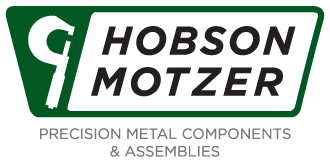Hobson Motzer, Inc. established in 1912 and now based in Durham, Connecticut, frequently tackles projects that other companies can’t handle. Hobson develops sophisticated manufacturing processes and designs tooling to produce precision metal stampings for companies worldwide.
After the September 11 terrorist attacks, Becton, Dickinson and Co. (BD), of Franklin Lakes, New Jersey, the world’s largest manufacturer of hypodermic needles, asking Hobson to quickly produce millions of delicate needles for the smallpox vaccine. Smallpox was finally eradicated in 1979, and the smallpox needle – three inches long with at tip that flattens into two tiny pitchfork-like prongs – ceased production. But with new worries over global terrorism, these needles were once again urgently needed, as well as a cheap, efficient way for the vaccine to be administered by minimally trained workers. BD dispatched a team armed with photos of smallpox victims, detailed drawings of needles and design specifications to brief a dozen Hobson professionals.
Figuring out how to produce millions of these delicate needles on short notice was the challenge of a lifetime for Hobson, while had to transform its metrology inspection process to meet the huge demand. Hobson had always used optical comparators or toolmaker’s microscopes for manual noncontact inspections.
The Hobson team began working 12-hours shifts around the clock. It designed a system that quickly turned out perfect needles by the millions. Hobson’s sophisticated manufacturing techniques require micron precision and the ability to measure increasingly complex characteristics of objects. The inspection metrology had to be noncontact because of the product’s delicacy and was required over high volumes. Hobson ran three manufacturing machines 24 hours a day. It became increasingly difficult to keep up with production volumes using normal toolmaker’s microscopes because of the huge number of parts requiring inspection.
To solve this problem, Hobson selected Nikon Instruments’ Nexiv VMR CNC video measuring system, which reduced a 15-minute manual inspection down to four minutes, freeing the inspector to perform visual inspections in parallel with the automated inspection. “The system was a huge first for us,” says Frank Dworak, president of Hobson Motzer. “Previously, we had used either optical comparators or toolmaker’s measuring microscopes to inspect products.” Nikon’s laser inspection system represents the ultimate in high-precision vision-based measuring.
The system features a 15:1 zoom ration yielding a wider field of view and higher resolution, a programmable LED illuminator and patented probes for easier edge detection. The system’s advanced progressive scan camera provides rapid image acquisition and increased system speed. With enhanced X-Y measurement capabilities, the U2-compliant system delivers precise and reliable readings. Finally, Nikon software offers offline programming and easy-to-use programming wizards. The Nexiv system ensures faster first-piece inspections and faster in-process inspections.
“Nothing here is ordinary,” says Jim O’Brien, vice president of operations for Hobson Motzer. “Our customers demand extremely high quality. We can only work as close as we can measure.”
Conducting gage repeatability and reproducibility (GR&R) testing with the noncontact laser inspection system delivers more consistent measurements on the machine vs. measurements recorded by numerous operators using toolmaker’s microscopes. The result was a huge improvement in GR&R quality values for Hobson.
“As Hobson grew their medical stampings business, the quality requirements demanded by their customers also grew,” said Mike Metzger, general manager, Nikon Instruments. “The system provided Hobson faster, more consistent quality data, and enabled them to meet the incredible manufacturing challenges posed by Becton, Dickinson.”
Hobson uses the same automated inspection technology for a variety of precision metal components, conducting edge and flatness checks and developing statistical capability studies so the company can inspect larger volumes of product. By implementing state-of-the-art laser inspection technology, Hobson has achieved consistent quality, streamlined the shop floor and attained new levels of innovation, making it possible to purse new mission-critical manufacturing opportunities well into the future.









